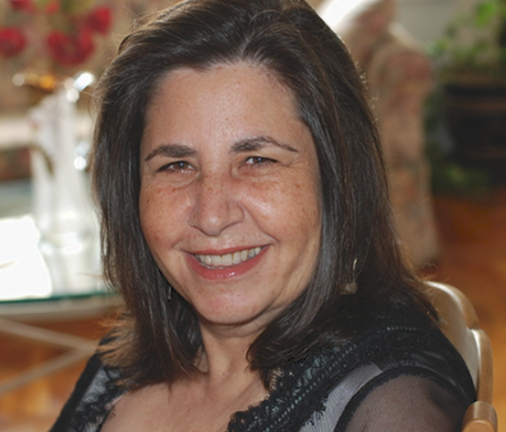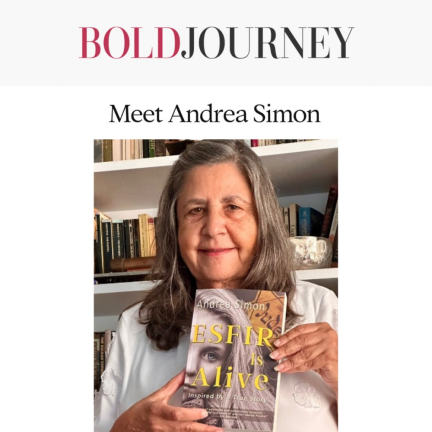Andrea Simon, an author living on the Upper West Side, wants to make sure people cannot deny the tragedy of the Holocaust and the ignorance that led to it.
Originally from Brooklyn, Simon has written multiple books on the topic, with one, “Esfir Is Alive,” being rereleased in 2024. Simon believes that now is a critical time for people to hear these stories, and is taking the steps to do that with her work.
This interview has been edited for length and clarity.
What first inspired you to write your book?
Originally, I wrote this book called “Bashert: A Granddaughter’s Holocaust Quest,” and “Esfir” is sort of a result of that first journey. So in 1997 I joined a holocaust-related group that visited Poland, Belarus and Russia—the first American group to go to these areas since the breakup of the Soviet Union. And I was very interested in going, because my grandmother and her family and actually my mother were born in a small village in Belarus called Voŭčyn, and I knew that we had relatives that died there during the Holocaust, and I thought this was my opportunity to go to that village and find out, maybe, more information about what happened — we never really found out what happened.
So during that trip, I found out that the Jews, which numbered about 350 or something, were all killed in a massacre in the area, and a lot of the area, small towns and villages, the same thing happened to them. And then we went to this site ... in Belarus, called Bronna Góra, it was a forest. In 1942 in October, over 50,000 Jews were killed there, and, you know, mass graves. I learned about this, and when I returned to the United States the leader of the group asked me to work on a documentary about what we discovered. And it didn’t work out, mainly because the person who was with us wasn’t a professional documentarian, and he didn’t really know about this, so he was pretty much filming people dancing and eating rather than what was going on. So I had, I started collecting all this information, and this was in the early days of the internet. So it was basically through letter writing, and, you know, the old fashioned way, and I got all this information, a lot about this massacre in that we talked about, it was called Bronna Góra, and one of the stories was about the only known survivor, a 12-and-a-half-year-old girl who was lying in the pit shot, and she managed to get out of the pit and run into the forest naked. In 1944 when the Soviets came to the area and they freed a lot of people, they interviewed her, and she gave three paragraphs of testimony about what happened to her.
So I thought about this for many years, like, how does a 12 year old girl survive such an experience? And I tried to find out about her. I could not find out about anything. So I started writing about what I expected her life to have been, pre-Holocaust, during the Holocaust, and I had gathered, by this point, so much information from the people who worked in the railroads who described the actual massacre that I recreated that in the book.
It was released in 2019, and then recently the publisher decided to rerelease some of the books and do different covers. So we re-rereleased it, and I’m trying to get it, now, out there again and focus more on getting them into schools, because I really feel like it’s important, especially in the current global environment — growing antisemitism — that it’s important for young people to know our history.
As you were writing, what kinds of research did you need to do?
Because I did such tremendous research for the first book ... I had all this stuff already around the house. So when this one came around, I tried to find the real Esfir to see if she was alive. I had people in Israel looking, we found somebody with a similar name, but it turned out we couldn’t find anything. So I decided I was going to recreate our village and also Voŭčyn where my parent my family was from. So I did some research about life in the village before the war, and so I did some added research, mostly from the internet and some of the books that I already had, about people who either survived or came to the United States before the Holocaust. I actually found a house, I said, this is Esfir’s house. And I was very careful, I found someone who I felt looked like her, I got clothing that they wore in those days, so I did that kind of research to supplement the events that happened, which I pretty much knew a lot of that stuff by that point.
And then I just created characters, including my relatives who were killed. I managed to insert them into Esfir’s life so I could write more about them. And I had photographs of them, so I had a visual. I’m also a photographer, so I write very visually, and I had pictures around me of all these relatives, and so they grew into people, you know? And it was a very cathartic experience for me, feeling like they were real.
What changed the most from the first draft to publication?
I mean, just how you fashion a novel, you know, it becomes more clear as you go from chapter to chapter. I had certain subjects that I wanted to cover, especially historical things like Kristallnacht and things like that. I wanted these things to be part of her life, to show people what happened in those times. So, you know, sometimes I had too much historical fact in there, so I spend a lot of time cutting it down, because it’s a novel, really, you don’t want to bore people. So I think mostly that the work was in editing more than anything else, and deciding what was important to the story.
Why was now the right time to bring this story back?
It really is very upsetting to me, you know, having studied antisemitism, to see this growing antisemitism, or to see people so polarized, or to see masses of people cheering people who are immoral, frankly, you know. And there’s so many echoes of Hitler and people raising their fists and ignorance and playing on prejudices that I just, I really feel like this is an important story. It’s important for people to know the history of antisemitism, what it does to people, and polarization, and morality, and how people could be easily swayed into doing immoral things. And I felt it was important to create characters, too, that you care about, because part of prejudice is ignorance. If you don’t care about people — you don’t really know them — you develop stereotypes about them. So, I think it’s very important now. I hear young people who don’t know anything about the Holocaust, and certainly there are Holocaust deniers that are reviving themselves. And I know “Basheret” has been often used as a vehicle to deny Holocaust deniers, because there’s so much information you can’t really deny it. So I just think it’s important for young people, especially, — even older people, but young people in particular. And I have given some talks in front of middle schools, and I was surprised how kids really responded to the story, and they saw the parallel of what was going on in this country without me having to hammer it down their head.

